From Desert to Port: How Oman's Inexperienced Hydrogen Could Electric power Germany’s Long run

Oman, Germany, and the Netherlands have signed a groundbreaking arrangement that might reshape Europe’s energy landscape, ushering in a whole new period of green hydrogen imports from the center East.
A Daring go in the global Strength transition is using shape in between Oman and Europe. A historic agreement signed earlier this calendar year paves just how for among the planet’s 1st massive-scale hydrogen corridors—linking Oman’s extensive renewable sources to Germany’s industrial hubs via the Netherlands.
The Main of the initiative is inexperienced hydrogen—made by splitting drinking water via electrolysis run by solar or wind Electricity. This kind of hydrogen has captivated world-wide interest for its likely to decarbonise sectors which can be or else challenging to electrify, which includes weighty transport, metal production, and Strength storage.
Oman, leveraging its sunny local weather and bold countrywide method, aims to be a top world exporter of eco-friendly hydrogen by 2030. Forecasts recommend the region could develop as much as one million tonnes of environmentally friendly hydrogen yearly by the top of the 10 years. A essential part of this approach entails liquefying the hydrogen to facilitate abroad transportation.
Enter the hydrogen corridor: a planned maritime and logistics route starting from the port of Duqm in Oman, extending on the ports of Amsterdam and Duisburg. Specialised cryogenic tankers, just like These Utilized in LNG website transport but adapted for hydrogen’s A lot lower temperatures, will have the gas. European ports are presently getting ready the mandatory infrastructure to obtain, retail store, and distribute the cargo.
This corridor is not merely a logistical feat—it’s a strategic a single. For Germany, which is aiming to lower dependence on fossil fuels and diversify its Electricity combine, the imports could aid meet its target of bringing in ten million tonnes of renewable hydrogen by 2030. The corridor also aligns with broader EU sustainability aims and industrial decarbonisation attempts.
The project’s importance lies not merely in its scale, but also in its replicability. Like LNG prior to it, liquid here hydrogen could before long move across continents, breaking no cost from the restrictions of mounted pipeline here networks. And Oman isn’t by itself. Other initiatives—such as Spain’s Basque Hydrogen Corridor along with the Central European Hydrogen Corridor—can also be setting up the spine of a foreseeable future hydrogen economy.
The Basque task focuses on integrating creation, distribution, and industrial use in northern Spain. Meanwhile, the Central European route plans to repurpose present gasoline pipelines to hold hydrogen from Japanese Europe to Germany, even further cementing more info the region’s function inside the hydrogen changeover.
If productive, these endeavours could mark a major milestone in decarbonising Europe’s heavy industries and transportation networks—driven with the Solar and wind of distant deserts.